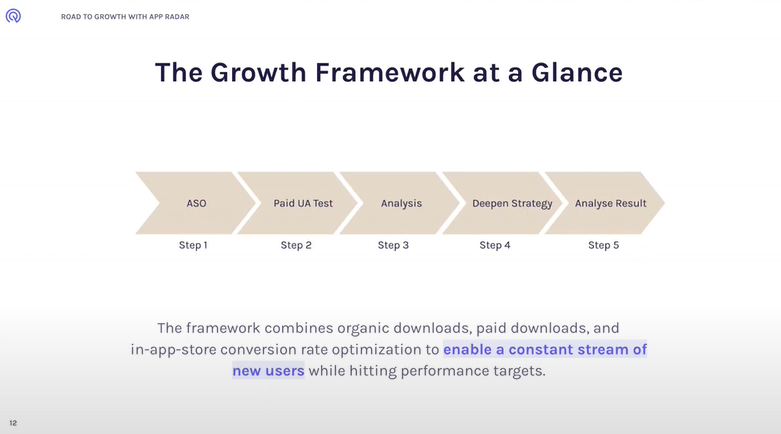Recap of Top 6 reports from App Promotion Summit London 2022

The App Promotion Summit London was held from 24–31 March 2022. We compiled the 6 most important reports on ASO and app marketing. In this article you will learn more about the state of the app economy in 2022, a case study about 5x growth of B&Q’s app, a framework for combining ASO & Paid UA, limitations of PPO and CPP, tips on how to combine ASO & ASA strategies and predictions on how ASO will change in 2022.
Contents
1. The State of the App Economy in 2022
2. Award-winning ASO Strategies: How we grew B&Q by 5x
3. Rethinking ASO in 2022
4. Road to Growth: A Framework for Combining ASO & Paid UA
5. Know the Limitations of Product Page Optimization & Custom Product Pages
6. How to Fuse ASO & ASA Strategies Using the Language of Data
Key insights from the App Promotion Summit London 2022
The State of the App Economy in 2022
Karl Knights, Managing Director data.ai
Data.ai shared important statistics on app developers and consumer behavior in 2021.

Source: App Promotion Summit London 2022, The State of the App Economy in 2022
1. Downloads. There were 230B app downloads in 2021 around the world. This is 5% more than in 2020 and 19% more than in 2019.
2. Hours spent on mobile devices. In 2021, users spent 4.8 hours a day on their mobile devices on average. This metric grew 30% in a year. This is ⅓ of waking hours, which is quite a lot of time.

Source: App Promotion Summit London 2022, The State of the App Economy in 2022
3. Mobile ad spend. Despite IDFA rules which make it difficult to track and measure user behavior, total spend on mobile ads grew. It totaled $295 billion in 2021, which is 23% higher than in 2020. Experts predict that in 2022 mobile ad spend will grow up to $350 billion.

Source: App Promotion Summit London 2022, The State of the App Economy in 2022
4. Consumer spend. The growth in app consumer spend was more significant, reaching 170 billion in 2021. Consumer spend grew 19% in 2020, and 42% in 2019.

Source: App Promotion Summit London 2022, The State of the App Economy in 2022
233 apps & games generated over $100 million annually in 2021. 13 of them surpassing $1 Billion. This means that a huge portion of the revenue comes from a small number of applications.
5. The number of published apps continues to grow. Incredibly, so predominantly on the Google Play platform, 77% of new apps were published in 2021.
The big markets for Google Play are India, Brazil, Indonesia, as well as key growth markets of Turkey, India, and Mexico. This is quite a different story on iOS, where the major markets are the US, China, Japan, and key growth markets of the US, Brazil, and Mexico.
6. Categories of apps with the biggest consumer spend. They divided apps into 19 genres, and 152 sub-genres consistent across all app stores.
We can see that it is entertainment apps from the genre of OTT, livestreaming and short videos driving most of the downloads.

Source: App Promotion Summit, The State of the App Economy in 202
OTT drives a significant amount of consumer spend along with livestreaming.
App Annie’s predictions for 2022:
- The entertainment app group may scale to 12 billion in 2022.
- Consumers will spend 9 billion on social apps in the App Store.
- Gen Z’s Mobile-First Financial Involvement is set to grow 160%.
Read the full State of Mobile in 2022 report.
Award-winning ASO Strategies: How we grew B&Q by 5x
Rishan Weerakoon, Growth Director, Yodel Mobile
Harry Blamire, Senior CX, Content, and Design Manager, B&Q
Rischan Weerakoon shared the concept of the loop which helps apps to grow and explained how ASO helps at every step. With this loop, the B&Q app gained 5 times more installs. Harry Blamire gave some practical tips which helped their app to succeed.
Rischan noticed that for achieving app growth we need a combination of 3 things: product, marketing, and commercial. The Yodel Framework is the infinite approach loop which consists of 2 important things: acquiring users and maximizing their value.

App Growth Loop
Let’s look at how ASO can help apps to grow at each step of this loop.
Acquire
At this step, we should work on paid user acquisition, organic, influence, PR, and ATL. It is important to drive app visibility in the app stores, as it drives volume and downloads. We should conduct keyword research and choose the right keywords to boost.
Compel
Here we are trying to convince the user to download the app and optimize our conversion rate. Our aim is to get a high conversion across paid and organic traffic sources and to learn how to use the app. We can do this with the help of screenshots, videos, icons, Google Play Store Experiments, Product Page Optimization, Customer Product Pages, and third-party solutions.
Activate & Retain
ASO helps convey your brand message. You should use a consistent brand tone of voice and a brand design language in ads and app pages. This way, users will not be lost when they enter the app page.
Feedback Collection
ASO can help to improve user sentiment, increase listing CVR, and identify product & retention issues. For example, Yodel’s client has a 3.7 rating on the Android app, while before this situation the rating was much higher. The ASO team helped to understand that this problem occurred because of the update in October.
Convert
Features in the app stores also help to monetize users. With In-app purchases in the App Store and LiveOps in Google Play, we can convince users to buy our app.
B&Q case study
Harry Blamire shared how they used this loop for the B&Q app and what results they achieved.
B&Q is an app for buying home, garden, and D&Y tools. At the beginning of 2021, the total percentage of digital sales of B&Q’s app drove only 3% of digital sales. But during the pandemic, there was a sudden shift of users moving away from mobile and desktop to the app.
They also noticed that app customers spend more and return more often. App users also had higher ARV and were much stickier. So they realized that app customers have the potential to be the most loyal customers.
The goal of their ASO campaign was to nurture this new stream of customers directly through mobile channels to the typical user.
They had a long-term and a short-term strategy in keywords research. The short term was focused on really relevant high intensity keywords, which had a very high volume. And the longer-term strategy was to use the keywords with high volume, competitors keywords that customers use in search, and similar long-tail keywords.
They also had different strategies for promoting in the app stores:
- For the App Store: focus on quality. In the App Store, you are limited by the number of characters that you can use in terms of your keyword upload. That is why you had to be precise and targeted with what we were going to go after.
- For Google Play: focus on volume. In Android, you can be a little bit broader.
They also work in collaboration with SEO teams. SEO strategy helps to understand how users think and behave when they try to find similar products and also pay attention to seasonality.
After finding all the necessary keywords, they made keywords prioritization. They tried to build a semantic core keywords bank and then choose long-tail keywords depending on their volume or quality.
They also focused on the optimization of screenshots and videos to maintain the high conversion. Harry expected that the brand traffic may decrease because they focused only on generic keywords.
Results of new ASO strategy
- They improved installs on generic keywords from 11% to 52%.
- Keyword visibility increased by 220%. The total number of words for which the app is indexed grew to 2291 words.
- Daily installs increased by 5x.
Editor’s note: Read our checklist for finding hypotheses that will help you increase app visibility and installs from the App Store and Google Play.
Rethinking ASO in 2022
Simon Thillay, Head of ASO, AppTweak
Simon noticed that the world of ASO is changing:
1. With ads in the App Store and Google Play, search is not only organic anymore. Because of ads we get useful statistics. Otherwise now it is more difficult to understand the number of organic installs.
2. With Customer Product Pages (CPP) there are more opportunities for segmentation. Now we can go deeper into what our audience wants to see and show them only that information.
3. In-app events in the App Store and LiveOps features can help to improve engagement and retention. It can also generate excitement about the event that will soon begin. In Google Play you can offer discounts with in-app events.
Simon shared that there was a good adoption rate for In-App Events among app publishers: about 28% of games from the top-50 have used them, and 20% of games from the top-250 used them at least once.

The ASO expert also predicted that Custom Detail Page may soon appear in Google Play. This is a store listing matching ad group creatives and text from Google UAC.
According to Simon, ASO skills shouldn’t include only optimization of app pages, they should be much wider. 3 skill domains can take part in the conduct of ASO:
1. Data analysis and data mining. It is important to understand what new metrics are added in Apple and Google and how they can influence on app promotion. The ASO team should also share this data with other teams and collaborate with them.
2. Marketing. The ASO team should target user interests that represent the intent behind them. You can learn about brand values and value propositions with keywords.
3. Product Management. On the app page, we can inform you of product improvements. We can also learn about certain issues from users’ reviews.

Source: App Promotion Summit London 2022, Rethinking ASO in 2022
Simon believes that soon there would be a cross-functional ASO team: one ASO specialist who is familiar with the marketing side can collaborate with the marketing team, and one person can collaborate with product managers, etc.
Soon a new role will be introduced — ASO Strategist. ASO Strategists need to stay up to date with what is coming out of the App Store and Google Play. They should monitor the new changes and decide what this particular app needs to do first. For example, not everyone needs to be doing In-App Events or Custom Product Pages. Some apps need to do PPO first because they need to figure out the best conversion for everyone.
The main point is that ASO is much more complicated than it was several years ago. ASO should now be a collaboration of product, marketing, data, and engineering.
Editor’s note: You can read some predictions of experts on what will be with ASO and app promotion in 2022.
Road to Growth: A Framework for Combining ASO & Paid UA
Thomas Kriebernegg, Managing Director & Co-Founder, App Radar
Thomas believes that the mobile growth journey should start with App Store Marketing. Every user that somehow sees an ad for the app will land on the App Store page and here is the most important breaking point of the complete user acquisition funnel.

ASO and paid traffic should work together. Thomas shared a framework that can lead to app growth.

Step 1: App Store Optimization
We should ensure that we use relevant keywords and that our product page is appealing. Key activities here are:
- To build up a keywords backlog for our app category.
- Identify focus keywords.
- Identify keywords where we already rank (ideally in the top 30) and push them to the top 10.
- Set up keyword ranking monitoring to track our keywords before making changes.
Step 2: Paid UA tests
Our goal in this step is to identify channels that support growth and bring relevant traffic to your app store page. We should focus on several key activities here:
- Advertising on native channels (ASA, Google App Campaigns) and exploring its impacts.
- Learn which keywords and messages work best by using different creatives and messages.
- Optimize channels separately and identify specific insights.
You can try different types of creatives:
1. Emotional. The idea of this creative is that it evokes positive or emotional responses from people.

2. Reward. Give people rewards for downloading the app.
3. Collaboration with famous people. For example, Headspace used a photo of John Legend in their creatives.
4. Feature-based. WhatsApp emphasizes that their app concentrates on privacy.

Source: App Promotion Summit London 2022, A Framework for Combining ASO & Paid UA
5. Emotional + feature. You can make creatives that are based both on emotions and features at the same time.
6. Fear-based. Tell the audience that with your app you can avoid some problems.

Source: App Promotion Summit London 2022, A Framework for Combining ASO & Paid UA
Step 3: Analysis
Here we should find overlapping strengths and weaknesses of Organic and Paid UA campaigns. Our key activities are:
- Compare our channels and identify winning keywords/messaging strategies.
- Analyze which creatives bring us the most clicks and installs.
- Get an overview of the performance of our channels.
- Understand the correlation between paid and UA efforts. Here we also should keep an eye on the cannibalization of brand keywords in Apple Search Ads.
Step 4: Deepen Strategy and push our ASO
We should use knowledge from ASO and advertising to scale our campaigns. The main activities here are:
- Transfer insights from our ads to our app store product page (ASO update). We should adjust keywords & messages based on findings from our text ads as well as creatives in ads and app store product pages.
- Push rankings of relevant and more competitive keywords by changing the keywords’ density and position within our app store product page.
- Scale best-performing campaigns and channels for further growth.
- Optimize for eCPI (Organic + Paid UA) through higher organic share.
Step 5: Analyze results
Our goal here is to evaluate key results and build the basis for the next iteration. We should focus on several activities:
- Discuss our findings in weekly/monthly growth loop alignments. We should align growth teams (ASO, UA) with our product teams, share findings and discuss potential optimization opportunities.
- Analyze and adjust our strategy based on combined data from Organic and Paid UA. Here we should find what works well and do it more often. We should also analyze why things aren’t working out, find ways to make them work or skip them.
- Create a standardized reporting structure. Align everybody in the team regarding which KPIs you are prioritizing and what the goals are.
As we see ASO and paid UA should work together to achieve app growth. After we went through all these steps we can start over again and scale our campaigns that worked well.
Know the Limitations of Product Page Optimization & Custom Product Pages – And How to Overcome Them
Dave Bell, CEO, Gummicube
Dave warned us about some limitations of Product Page Optimization (PPO) in the App Store:
1. You can run only one test at a time. If a developer wants to run a test for multiple territories, they should do it separately and at different times.
2. You have limits on what you can test: only screenshots, app icons and app reviews videos. Metadata field testing is not available. User-facing metadata elements like the title and subtitle cannot be tested.
3. Icons are tied to binaries. If icons are of interest, all test variants of the icon must be incorporated into the binary for a formal build release before being eligible for a test setup.
4. The PPO is for iOS 15 users only. 80% of Apple users currently have iOS 15 installed, but 20% don’t have it so you can’t draw conclusions about the behavior of all user groups.
5. You can’t parse through INTL metrics. Developers can run a test on multiple territories, but all metrics are aggregated — it would be difficult to measure individual county performance.
6. Lengthier review process. All PPOs require Apple Reviews so developments may not be executed as swiftly as intended. Just prepare for that to wait in line for a little while. This is because you are waiting for Apple to review your trade-offs.
Customer product pages (CPP) also have some limitations:
1. Smaller slices of traffic. CPPs will only capture those who have interacted with the link.
2. CPP is not 100% customizable. You can change only promotional text, screenshots, or videos here.
3. You can’t use the CPP link on some external marketing channels such as Facebook or Google Ads.
4. Privacy changes affect reporting. When you’re sending traffic in from channels, and people have opted out of tracking their impressions, you’re going to see some impressions drop between the channel and the page.
5. Cannibalizing external traffic. External channels compete against each other for a share of an ad, which is why it will be more difficult to effectively implement a target.
6. Possibly inaccurate data. Reporting and analytics can vary a lot between platforms. We do see a difference between metrics in the App Store and external metrics.
7. Lengthier review process. CPP also requires all submissions to go through a review process similar to the PPO track.
To sum up, PPO and CPP can’t always give us a full picture. You should strategically execute an A/B testing strategy that accounts for limitations by diversifying your A/B testing strategy channels to maximize conversion.
How to Fuse ASO & ASA Strategies Using the Language of Data
Luisa Ronchi, Director of ASO and UA, ConsultMyApp
Ryoma Nelson, Director of Analytics, ConsultMyApp
Luisa ran us through some really interesting scenarios where you can use data-driven techniques to enhance strategies. She covered how a data-driven approach can make sure your organic strategy and your ASA efforts are aligned and support each other.
1. You can use ASA campaigns to boost your organic downloads. So this is showing how well after running these we can see that we can relate and we can see that the keywords improve as you run your apple search ad campaigns.

2. With ASA data you can understand how your keywords are performing. You can see the conversion rate and what rates you will have from different keywords.

Green lines are keywords that are performing well — or have good conversion. Red lines are keywords that are performing badly. The bottom chart is representative of your keyword ranking for particular times. And the top chart is your share of voice. The Thickness of the line is the estimation of daily keywords. By mixing all of these metrics, you can use that in your favor and optimize your organic setup.
It’s taking all the data sources that you have available from Mobile Measurement Partners (MMP) and your Apple Search Ads platform and making decisions that will help you and will push you to be better on your organic strategy.
3. Use ASA data for prioritizing Custom Product pages
We can prioritize custom product pages based on statistics of impressions or revenue. You can decide what is more important for you. Compared to where we were previously with just the branded generic screenshots, we’ve seen that we had a conversion which was around 4%.

It has now gone up 6.3%. So we improved the conversion rate in this case by having those custom product pages aligned with what users were actually searching for.
Editor’s note: Read more about how to find keywords for ASO which will maximize app revenue in our article.
4. Avoid cannibalization by splitting ASA and organic data and take steps to reduce conflicts.
It is true that when you do run those Apple Search Ad campaigns, you might see cannibalization happening — especially if you are using a lot of those campaigns on your brand.
Here you should consider several important things:
- If competitors bid on your brand. Check if your competitors buy ads on your brand keywords via ASO tools or search in the App Store. You don’t need to defend your brand if competitors don’t buy ads on your keywords.
- Your brand power. Check how loyal your users are and if your brand is popular.
- Tracking Impression Share (brand campaigns). This can help you see how likely a user is to download another app instead of your app.
- Negative keywords. Look at what keywords you have the top positions for and turn off campaigns on these keywords because you may cannibalize traffic for them. You can also test it by switching off campaigns one by one.
As we can see, Apple Search Ads can make our ASO performance better. It can improve keyword ranking and visibility, help to understand how your app keywords are performing and make it easier to prioritize Custom Product Pages. But you need to split ASA and organic data to avoid cannibalization.
Key insights from the App Promotion Summit London 2022
1. According to Data.ai the social media and entertainment apps consumer spend may grow to $9 and $12 billion in 2022. Financial apps are set to grow by 160%.
2. To increase app growth greatly you need to implement ASO in every step of app growth.
3. For bigger results in ASO, you should have 3 skill domains: data analysis & mining, marketing, and product management.
4. You should combine ASO & paid traffic to achieve maximum app growth.
5. Product Page Optimization and Customer Product Pages have some limitations which you should take into account when planning your strategy.
6. Apple Search Ads can help your app grow organically. ASA data also can help you to make the right decision in your ASO strategy.
We hope that these expert tips from App Promotion Summit 2022 will make your app promotion more efficient. Subscribe to our newsletter to receive useful articles on ASO, app marketing, and working with reviews.










